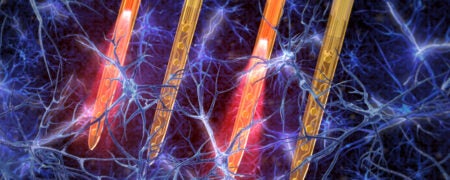Professor Josef Rauschecker’s research on hearing loss and tinnitus is aimed at understanding the brain mechanisms of this wide-spread disorder, and at the development of more intelligently designed hearing aids and neural prostheses.
Tinnitus, a mostly whistling, buzzing, or hissing phantom sound perceived in the absence of a corresponding external stimulus, causes suffering in about 15% of the adult population (45% in the elderly), and to date no reliable cure has been found. The causes of tinnitus are still poorly understood. The fact that it persists after section of the auditory nerve indicates that its origin lies within central auditory structures, but non-auditory structures seem to contribute as well. The following specific hypotheses about tinnitus generation are formulated.
Damage to the auditory periphery (e.g. as a consequence of loud-noise exposure or aging) causes some central auditory neurons to lose their input. We hypothesize that, similar to the remapping that occurs in somatosensory cortex after amputations of a limb, areas of auditory cortex affected by hearing loss start responding to lesion edge frequencies. This assumption is corroborated by the fact that patients with hearing loss show increased sensitivity for hearing-loss edge frequencies. The resulting imbalance in neuronal activity is interpreted as a sound signal the tinnitus.
As not all patients with hearing loss perceive tinnitus, activity in non-auditory structures are assumed to regulate neuronal auditory activity and prevent tinnitus perception. A likely candidate for such a structure is the paralimbic nucleus accumbens. This part of the ventral striatum has excitatory connections to the reticular thalamic nucleus (RTN), which in turn can inhibit the medial geniculate, the thalamic relay between inferior colliculus and auditory cortex. In tinnitus patients, NAc gray-matter volume is significantly reduced compared to healthy controls. Thus the volume-reduced NAc of tinnitus patients may fail to exert the inhibition necessary to block the excessive activation ultimately giving rise to the tinnitus percept. Intriguingly, like tinnitus, activity in the subcallosal area (including the NAc) is modulated by stress and sleep deprivation.
The aims of the proposed research are to:
- Provide direct evidence for reorganization of tonotopic maps in central auditory structures using high-resolution functional MRI, both in tinnitus patients and in patients matched for hearing loss who do not perceive tinnitus, and
- Investigate the role of the NAc in tinnitus by (a) comparing NAc volume in tinnitus patients and patients matched for hearing loss who do not perceive tinnitus, using high-resolution structural MRI and voxel-based morphometry, and (b) comparing, by means of high-resolution functional MRI, activation in central auditory structures and the NAc of patients with intermittent tinnitus in periods during which they do perceive tinnitus and periods during which they do not.
Predictions are that reorganization of tonotopic maps will be found in all patients with hearing loss, but reduced NAc volume and activity only in patients who do (at the time of measurement) perceive tinnitus. These results would guide tinnitus research into a new direction and open up a new point of intervention by emphasizing the modulatory role of extra-auditory structures responsible for the direction of attention.
Sponsors include: NIDCD, Tinnitus Research Initiative, and Tinnitus Research Consortium.
Joint Work With:
Additional Research:
“Does Tinnitus Depend on Time-of-Day? An Ecological Momentary Assessment Study with the “TrackYourTinnitus” Application“; Frontiers in Aging Neuroscience
“Auditory-limbic interactions in chronic tinnitus: Challenges for neuroimaging research“; National Library of Medicine, Leaver, A.M., Seydell-Greenwald, A., Rauschecker, J.P. (2016) Auditory-limbic interactions in chronic tinnitus: challenges and future directions for neuroimaging research. Hearing Research 334:49-57.
“Frontostriatal Gating of Tinnitus and Chronic Pain“; National Library of Medicine, Rauschecker, J.P., May, E., Maudoux, A., Ploner, M. (2015) Frontostriatal gating of tinnitus and chronic pain. Trends in Cognitive Sciences 19 (10), 567-578.




